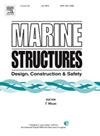全柔性张力腿式浮动风力涡轮机的时域仿真、疲劳和极端响应
IF 4
2区 工程技术
Q1 ENGINEERING, CIVIL
引用次数: 0
摘要
本研究探讨了一种张力腿平台(TLP)浮式风力发电机(FWT)在所有浮式平台部件均为柔性(弹性)时的动力响应。在之前的工作中,先进的气动-液压-伺服-弹性模型已经通过模型试验进行了验证,现在可以扩展到具有柱和浮筒的张力腿平台。首先,在工程工具SIMA中建立了4个耦合数值模型。其中两个将整个平台(漂浮物)表示为完全柔性体,而另外两个将其视为刚体进行比较。塔,叶片和肌腱被认为是灵活的所有模型。在具有柔性平台的模型中,水动力载荷要么基于莫里森方程,要么基于势流理论,并沿体分布。在静水、规则波和湍流-不规则波组合条件下的完全耦合时域模拟用于比较平台、塔和肌腱不同位置的整体运动和局部截面内部载荷。研究了沿结构的疲劳损伤和极端轴向应力(使用改进的环境轮廓法获得)。平台柔性影响平台的垂摇和俯仰自然周期和运动幅度,尤其是第一弯曲模态固有频率。因此,所有结构构件在第一弯曲固有频率处的截面荷载受到很大影响,并且在波频处的肌腱轴向应力也发生了显著变化。总体而言,采用柔性平台模型可以降低沿塔和肌腱的疲劳损伤和极端应力预测。对于这款TLP FWT, morrison的模型预测了更大的疲劳响应。对于停车工况下的极端轴向应力,第一弯曲模态固有频率下的共振响应占主导地位。本文章由计算机程序翻译,如有差异,请以英文原文为准。
Time-domain simulation, fatigue and extreme responses for a fully flexible TLP floating wind turbine
This study explores the dynamic responses of a tension leg platform (TLP) floating wind turbine (FWT) when all components of the floating platform are considered as flexible (elastic). Advanced aero-hydro-servo-elastic models modelling the platform with beam elements, which have been validated with model tests in previous work, are now extended to a TLP with column and pontoons. First, four coupled numerical models were established in the engineering tool SIMA. Two of them represent the entire platform (floater) as a fully flexible body, while the other two treat it as a rigid body for comparison. The tower, blades, and tendons are considered flexible for all models. The hydrodynamic loads are based on either Morison’s equation or potential flow theory, and are distributed along the body in the models with flexible platform. Fully coupled time domain simulations in still water, regular waves, and combined turbulent wind-irregular wave conditions are used to compare global motions and local sectional internal loads at different locations on the platform, tower, and tendons. Both fatigue damage and extreme axial stresses along the structure (obtained using a modified environmental contour approach) are examined. Platform flexibility influences the platform heave and pitch natural periods and motion amplitudes, particularly at the first bending mode natural frequency. Consequently, the sectional loads of all structure members at the first bending natural frequency are largely affected, and tendon axial stress at the wave-frequency also changes significantly. Overall, the adoption of a flexible platform model results in lower fatigue damage and extreme stress prediction along the tower and tendon. For this TLP FWT, Morison’s models predict larger responses for fatigue. For the extreme axial stresses in parked conditions, resonant responses at the first bending mode natural frequency are dominant.
求助全文
通过发布文献求助,成功后即可免费获取论文全文。
去求助
来源期刊

Marine Structures
工程技术-工程:海洋
CiteScore
8.70
自引率
7.70%
发文量
157
审稿时长
6.4 months
期刊介绍:
This journal aims to provide a medium for presentation and discussion of the latest developments in research, design, fabrication and in-service experience relating to marine structures, i.e., all structures of steel, concrete, light alloy or composite construction having an interface with the sea, including ships, fixed and mobile offshore platforms, submarine and submersibles, pipelines, subsea systems for shallow and deep ocean operations and coastal structures such as piers.
 求助内容:
求助内容: 应助结果提醒方式:
应助结果提醒方式:


